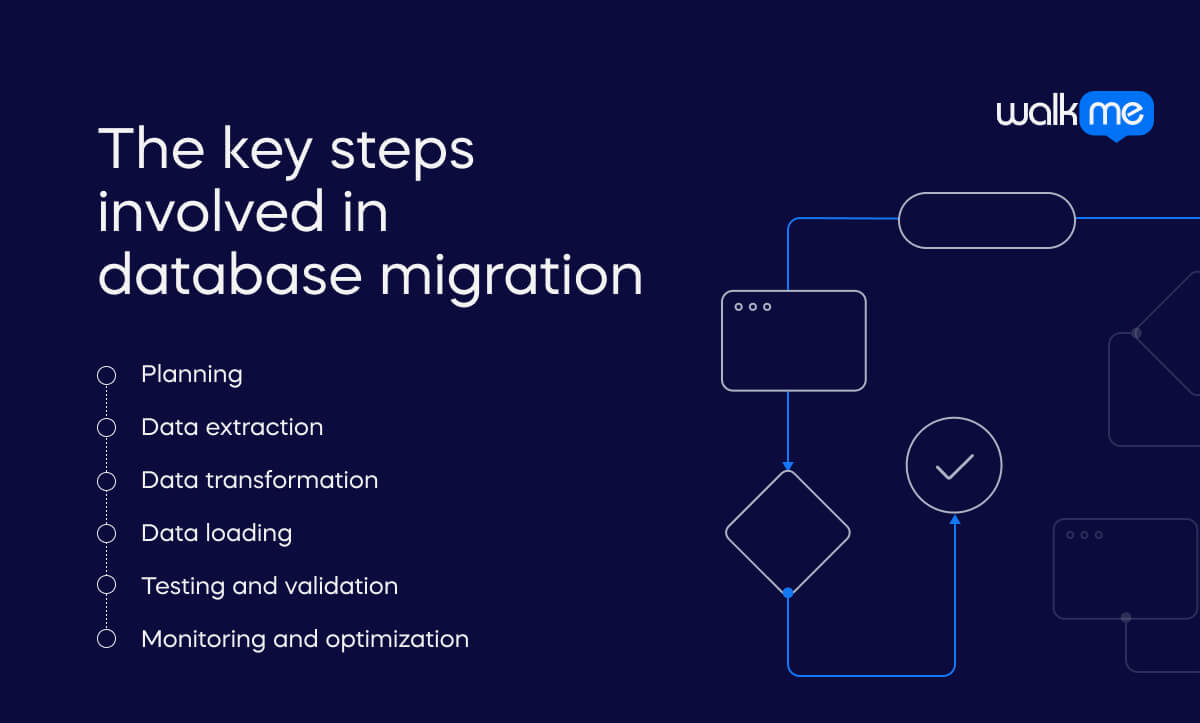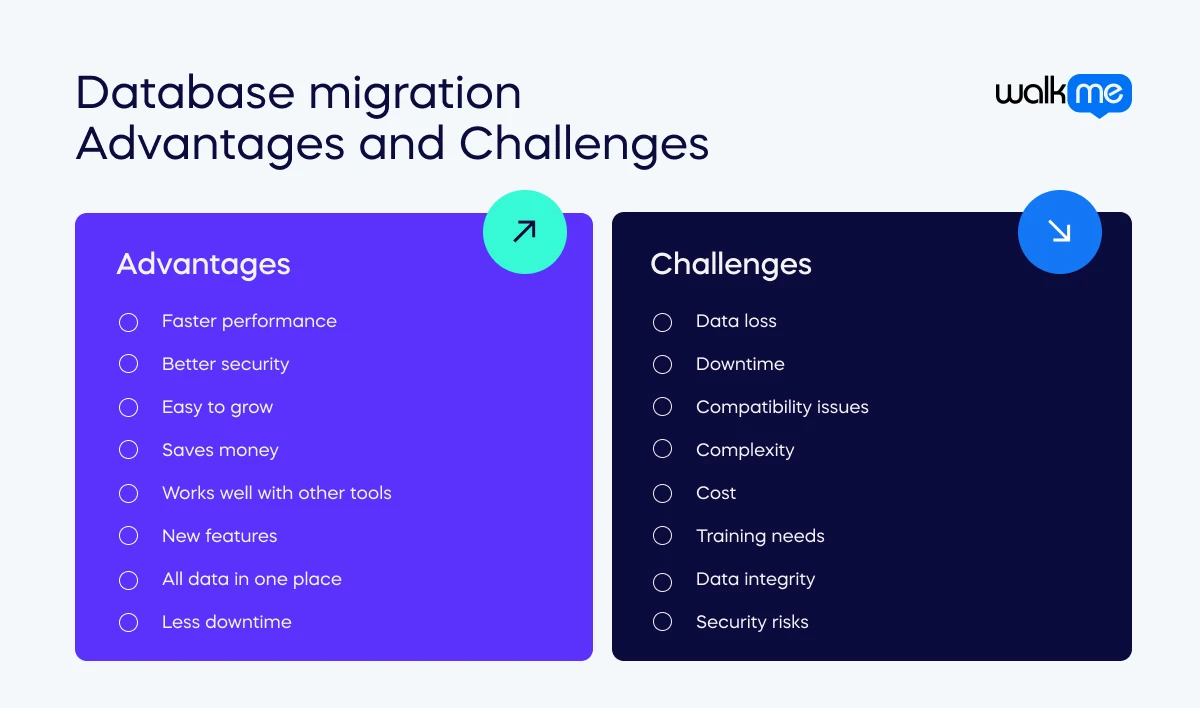What is database migration?
Database migration is when data is moved from one database to another. This is important for businesses that need to upgrade their technology or switch to a better system. It helps companies stay up-to-date and keep their data management running smoothly.

A successful migration ensures the new database works well and keeps data safe. Without proper migration, businesses might experience slower performance or lose data. Checking that the new system is correct and performs well after the move helps prevent problems and ensures that the company continues to succeed. Research on data migration projects reveals that only 36% have been kept to the forecasted budget.
Furthermore, less than half were planned and forecasted effectively. As these patterns happen for data migration projects, there are likely to be similar patterns with database migration projects. A lot goes into creating a successful database migration project. For example, factors including creating a Python script to automate migration, setting up DNS records with a low TTL, and monitoring replication lag resulted in the GOV.UK Notify service migrating their PostgreSQL database with just 11 seconds of downtime.
What are the key steps involved in database migration?

Understanding the main steps involved in database migration is important for securely moving data from one place to another. These steps help ensure the process is safe, correct, and quick without causing too many problems. Let’s look at what is needed to make database migration go smoothly.
Planning
First, determine what needs to be moved and how to do it. This includes deciding what data will be transferred and making a schedule.
Data extraction
Next, remove the data from the old database. This is like copying the information so it can be moved.
Data transformation
After that, adjust the data if needed. This means changing it to fit the new database.
Data loading
The adjusted data will then be put into the new database, making it available in the new system.
Testing and validation
Check that everything is correct and working well in the new database. This step makes sure the data is moved properly.
Monitoring and optimization
Finally, monitor the new database to fix any problems and ensure it runs smoothly.
Database migration vs application migration
Database migration and application migration both deal with moving digital assets. However, they have different focuses.
- Database migration involves moving data between databases.
- Application migration is when applications are moved.
Let’s look further at the differences between these two terms.
| Database migration | Application migration | |
| Definition | When data is moved from one database to another, it ensures the information stays correct and works well in the new system. | When an application is moved from one place to another, like from a company’s servers to the cloud, it is ensured that it will work in the new environment. |
| Focus | Moving data correctly and making sure it works well in the new database. | Making sure the application works properly in a new place or setup. |
| Techniques | Copying data, changing it if needed, and then putting it into the new database. | Adjusting or rewriting parts of the application so it works well in the new environment. |
| Goals | Move data to a new system without losing or corrupting it. Improve how the data is handled. | Ensure the application runs well in a new environment. Enjoy benefits such as better performance or lower costs. |
| Examples of use | Moving data from an old system to a new one that handles large amounts of information better. | Moving software from a company’s own servers to a cloud service to save money and gain better performance. |
Use cases for database migration
Database migration is important in many business situations. Moving data to a new, faster system, shifting data to the cloud for easier access, or combining data from different companies after a merger requires careful planning. Here are three simple examples that show how database migration can be used in different business cases.
Upgrading technology
When a company wants to use new technology, it must move its data from an old database to a new one. The new database is faster, safer, and has better tools to help the company work with its data. This makes it easier for the company to find, use, and protect important information. The new database allows the company to do things more quickly and safely. The new tools also help the company stay organized and grow in the future, which means the company can work better and get more done.
Switching to cloud storage
A business might move its data from computers in its office to a cloud-based system. The cloud is a way to store data online instead of on local machines. This switch gives the business more space to store data and makes it easy to access from anywhere with the internet. With the cloud, people can work from different places, like home or on the go, and still access the company’s data, making collaboration easier. The cloud can save money because businesses don’t have to buy or fix as much equipment. The cloud stores and protects the data, making things simpler for the business.
Consolidating systems
When two companies merge, they often combine data from different systems into one. Each company may have its own way of storing important information like customer details and money records, but combining all this information into one system makes it easier to manage. Having everything in one place helps the company find what it needs quickly. Workers don’t have to check different systems to get the information. It also helps avoid mistakes and makes sure everyone has the right details. Combining the data makes things easier and allows the new company to run better.

What are the advantages of database migration?
Switching to a new database system has many benefits for businesses. It helps everything work faster, keeps data safer, and provides better tools for managing information. This makes it easier to find and use data and improves a business’s performance. Let’s look at how moving to a new database can help a business.
Faster performance
New databases work much faster than older ones, allowing the business to process data more quickly. This speed helps employees complete tasks quicker and improves customer service. A faster database can also handle more data without slowing down.
Better security
Newer databases come with stronger security features to protect important data. These features help keep sensitive information safe from hackers and unauthorized access. Better security means the business can avoid data breaches and keep customer trust.
Easy to grow
As a business grows, it needs a database to handle more data and users. New databases are designed to scale easily to grow with the company, so the business won’t have to worry about running out of space or needing a new system.
Saves money
Moving to a cloud database or more efficient system can lower a business’s costs. The company won’t need to spend as much money on equipment or maintaining servers, and cloud databases also reduce the need for regular hardware upgrades.
Works well with other tools
New databases are designed to connect easily with the business’s other software and tools. This makes it easier for different teams and systems to work together. Better integration leads to smoother operations and fewer errors.
New features
Upgraded databases come with new and helpful tools like automatic backups and better ways to organize data. These features make storing, finding, and using important information easier for the business. The new tools also help improve efficiency and save time.
All data in one place
Migration allows the business to combine all its data into one system. This makes it easier to manage and find what’s needed quickly. Having all the data in one place reduces confusion and helps the business stay organized.
Less downtime
Newer databases are more reliable and have fewer issues. This means the system is less likely to crash, and there will be fewer delays. With less downtime, the business can keep running smoothly and avoid costly disruptions.
What are the challenges of database migration?
While a new database can be very helpful, it can also result in some problems. These can include losing data, having the system unavailable for a while, and issues with ensuring everything works together. Knowing about these challenges can help businesses plan better for the move.
Data loss
Sometimes, important data might be lost or damaged during migration. To prevent this, it’s important to make a backup of all data before starting the move.
Downtime
During the move, the database might not be available for a while, which can interrupt business work and slow things down. To reduce these problems, it’s best to plan the migration during times when the business is less busy.
Compatibility issues
The new database might not always work perfectly with existing software or systems, which can cause problems with data use. Testing the new system before fully switching can help fix these issues.
Complexity
Moving data can be complicated and take a lot of time. It often requires careful planning and technical skills. Businesses might need help from IT experts to ensure everything goes smoothly.
Cost
The migration process can be expensive, especially if new equipment or extra help is needed. It’s important to plan and budget for these costs.
Training needs
Employees might need to learn how to use the new database, which can take time and effort. Good training will help them adapt to the new system.
Data integrity
It’s important to keep data accurate and consistent during the move. There’s a risk of data being changed or damaged. Checking and testing the data helps ensure it stays correct.
Security risks
Moving data can expose it to security risks, especially if transferred online. It is crucial to ensure that data is protected throughout the migration.
How can DAPs help with database migration?

Digital adoption platforms (DAPs) can make moving to a new database much easier. They provide tools and support to help with the move, making it simpler and smoother. Businesses get clear steps, staff training, and help with problems with a DAP. Let’s see how DAPs can help move to a new database more smoothly.
Guided steps
These tools provide clear instructions and step-by-step guides to help with the migration. They make it easier to follow each part of the process, ensuring everything is done correctly and smoothly.
Training
They offer training and support to teach staff how to use the new database. This includes lessons and online resources to help everyone use the new system.
Error detection
These tools can spot and fix problems during the migration. They help to find issues early to prevent them from becoming bigger problems.
Data mapping
Digital adoption tools help organize and move data correctly from the old system to the new one. This ensures that data stays in order and is easy to find in the new system.
User support
They provide help and answers to any questions during the migration. This support reduces confusion and helps prevent mistakes, making the move to the new system easier.